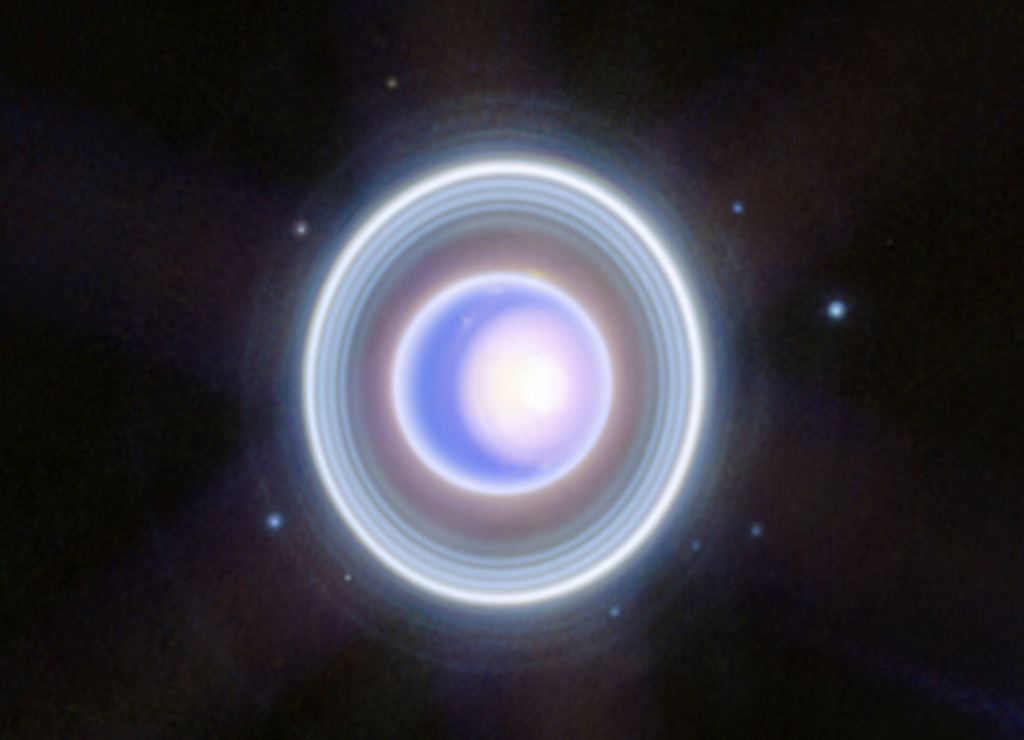One cool thing about Uranus is that its orientation, compared to the rest of the solar system, allows a unique perspective of the planet from our home planet. It is tilted at 98° compared to the rest of the ecliptic plane. So, when viewed from Earth, we can see its North Pole and its rings in some exceptional cases. That perspective is fully displayed in an image of Uranus recently released by the European Space Agency (ESA) and captured using the James Webb Space Telescope (JWST).
JWST is the most powerful space telescope currently in service, but even it has trouble when attempting to capture an image of Uranus. The planet spins relatively rapidly, with a day lasting only 17 hours. With the long exposure times that are sometimes required by instruments on the JWST that means that entire storm systems could physically move across the planet’s surface, thereby blurring the image of the planet. Not only that, but the system’s moons move relatively rapidly as well, creating what looks like arcs of light around the planet during long exposure times.
To get around this, JWST’s handlers combined exposures of several lengths to create a breathtaking picture of the planet, its rings, and some of its moons, all in one epic shot. Let’s start with the planet.
As mentioned above, Uranus is lying on its side, meaning that from Earth’s perspective (or, in JWST’s case, the perspective from the L2 Lagrange point), we see Uranus’ north pole straight on. In the case of this image, its pole is covered in an ice cap that is typically only visible in the summer when it is in direct sunlight. You can even see a difference between the brighter “inner” cap on the planet’s right and the darker “bottom” cap to the left.
Probably the most striking feature of the image, though, is the rings. Uranus has an obvious pattern of rings, and some, like the “Z-ring,” which is the diffuse ring closest to the planet itself, are very hard to see with typical instruments but show up clearly in the JWST image. The outer rings are slightly harder to distinguish in the image, but at specific points, they are clearly separated from the more extensive ring system by a gap, much as the middle rings are. This is undoubtedly one of the most striking pictures ever taken of the 7th planet’s ring system.
Another impressive feature of the image is that you can clearly see nine of Uranus’ 27 moons on display. Captured the way they were, they almost appear to be background stars. However, they are some of Uranus’ smaller moons – none of the five major ones appear in the image, likely because they were too far away to be picked up by JWST’s concentrated gaze.

Credit – NASA / ESA / CSA / STSci
The nine visible moons include Rosalind, Puck, Belinda, Desdemona, Cressida, Bianca, Portia, Juliet, and Perdita – Rosalind is located in the upper right of the image at two o’clock, and the rest follow in a clockwise direction. They range in size from Puck (162 km diameter) down to Perdita (30 km diameter). Most are named after Shakespeare characters, as are most of Uranus’ moons. The one exception in this image is Belinda, who is named after a character in Alexander Pope’s The Rape of the Lock.
Undoubtedly, some science can be done with this image, but ESA’s press release doesn’t mention what, if any, science is taking place on it. Sometimes, it’s just great to have a telescope that can take such stunning and unique pictures, and JWST’s operators sure know that. Most space fans will be happy to add such a stunning image of one of our solar system’s most unique worlds to humanity’s catalog.
Learn More:
ESA – Uranus close-up view (NIRCam)
UT – The Planet Uranus
UT – Uranus Has Infrared Auroras, Too
UT – Seasons on Uranus
Lead Image:
Uranus captured by JWST.
Image credit: NASA, ESA, CSA, STScI

